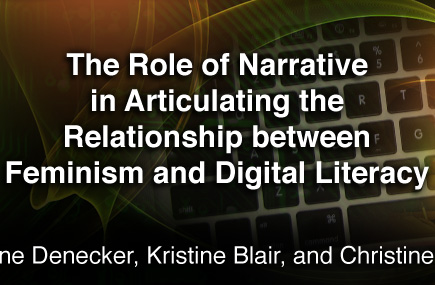Chris Denecker: When Narratives of the Past Meet the Present
In their introduction to The Norton Anthology of African American Literature (2004), Henry Louis Gates Jr. and Nellie Y. McKay quote the words of nineteenth century journalist and author Victoria Earle Matthews:
The lesson to be drawn from this cursory glance at what I may call the past, present and future of our Race Literature apart from its value as first beginnings, not only to us as a people but literature in general, is that unless earnest and systematic effort be made to procure and preserve for transmission to our successors, the records, books and various publications already produced by us, not only will the sturdy pioneers who paved the way and laid the foundation for our Race Literature be robbed of their just due, but an irretrievable wrong will be inflicted upon the generations that shall come after us (p. xxxvii).
Matthews’ 1895 call to examine African American (“Race”) literature speaks to the urgency of preserving culture, honoring heroes, and recognizing the voices and contributions of those who have been marginalized so that future generations are not “robbed” of their legacy, of their stories. As Matthews might contend, these stories “speak to us” and give us a greater understanding of the past, a clearer picture of the American narrative, and, ultimately, a stronger notion of ourselves.
Interestingly, the contemporary words of the DALN Collective (this collection) about digital literacy narratives just as aptly describe the value of studying the "stories" of African American literature; such literary narratives “bring alive our scholarly understandings” of the “complex cultural, political, ideological, and historical contexts which shape and are shaped by those practices and values associated” with racialized cultures (p. 1). More importantly, in their recent “earnest and systematic” work of creating a Digital Archive of Literacy Narratives, Cynthia Selfe and her colleagues parallel Matthews’ sense of urgency that something valuable may be lost if people’s stories, here, specifically, their literacy narratives, are not procured and preserved. These narratives the DALN Collective maintains are “powerfully rhetorical linguistic accounts through which people fashion their lives, make sense of their world, and indeed, construct the realities in which they live” (2010, p. 1). Similarly, Toni Morrison’s (1987) argument that slave narratives “are instructive, moral, and obviously representative” (p. 185) applies as well to many narratives found in the DALN. In both cases, the collecting and studying of each of these separate bodies of “literature” holds the potential to reveal a culture in transition and to better understand the complicated phenomenon called “literacy” as an element of the larger “American Story.”
Therefore, although incorporating the discussion and analysis of specific DALN artifacts into an African American literature course may at first seem an odd marriage of methods to means, the two richly complement each other. Such a feminist pedagogical approach engenders the type of welcoming and formative learning space Kris Blair describes in her section—a space where inclusion, collaboration, and exploration are key components. The goal of this pedagogical design is to provide students with the opportunity to develop their awareness of the impact of narratives as they inquire into the works of Frederick Douglass and Harriet Jacobs, follow the primary research of teacher-scholar, David Blight, in A Slave No More (2007), scroll through the web pages of DocSouth’s collection of North American Slave Narratives, and unearth stories from Benjamin Drew’s nineteenth century work, A North-Side View of Slavery—all before turning to the contemporary digital narratives of Hazel Williams and Jessie Blackburn, women whose literacy stories provide connection to the past and to the present as well as contemplation of the future.
Hazel Williams' Video File
(transcript)
Jessie Blackburn's Audio File
(transcript)


